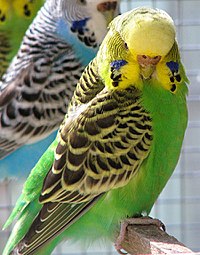
Back خضاب حيوي Arabic Pigmentos en seres vivos AST জৈব পিগমেন্ট Bengali/Bangla Biološki pigment BS Pigment biològic Catalan Pigment (Biologie) German Biologia pigmento Esperanto Pigmentos en seres vivos Spanish Pigmentu biologiko Basque رنگدانه زیستشناسی Persian

Biological pigments, also known simply as pigments or biochromes,[1] are substances produced by living organisms that have a color resulting from selective color absorption. Biological pigments include plant pigments and flower pigments. Many biological structures, such as skin, eyes, feathers, fur and hair contain pigments such as melanin in specialized cells called chromatophores. In some species, pigments accrue over very long periods during an individual's lifespan.[2]
Pigment color differs from structural color in that it is the same for all viewing angles, whereas structural color is the result of selective reflection or iridescence, usually because of multilayer structures. For example, butterfly wings typically contain structural color, although many butterflies have cells that contain pigment as well.[3]
- ^ "biochrome - biological pigment". Encyclopædia Britannica. Retrieved 27 January 2010.
- ^ Lackmann AR, Andrews AH, Butler MG, Bielak-Lackmann ES, Clark ME (23 May 2019). "Bigmouth Buffalo Ictiobus cyprinellus sets freshwater teleost record as improved age analysis reveals centenarian longevity". Communications Biology. 2 (1): 197. doi:10.1038/s42003-019-0452-0. PMC 6533251. PMID 31149641.
- ^ Stavenga DG, Leertouwer HL, Wilts BD (June 2014). "Coloration principles of nymphaline butterflies - thin films, melanin, ommochromes and wing scale stacking". The Journal of Experimental Biology. 217 (Pt 12): 2171–80. doi:10.1242/jeb.098673. PMID 24675561. S2CID 25404107.